
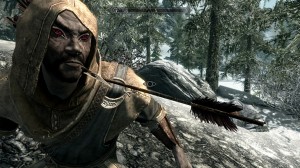
So, in case you’ve missed all of the commercials and high praises from the bulk of the gaming community, The Elder Scrolls V: Skyrim came out on 11/11/11. Now, a week and a half later, I finally feel like I’ve put in enough time with this game to form a complete opinion on it. The thing you need to realize is that this is still a Bethesda game. The combat is definitely improved over Oblivion, and the conversation system is a lot less formal, but this is still a game from the guys that made Oblivion and Fallout 3. Much of the game is spent wandering around the Nordic province of Skyrim, completing quests and discovering various forms of dungeon. If those mechanics weren’t your bag before, I’m not sure that they will be now. Along with that, you’ll have to put up with a little bit of sandbox wonkiness and some goofy stuff that goes on. But, if you’re still interested, then read on and find out why I’m still itching to play more after 75 hours.
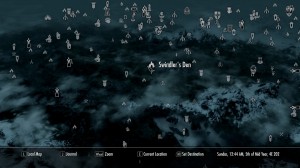
The main quest, as with most Bethesda games, makes up much less of the game than its heaps upon heaps of side quests, but it still bears talking about. The situation boils down to this: the northern province of Skyrim, home to the Nords, is in the midst of a civil war between the Empire and the rebel Stormcloaks, but it’s essentially a stalemate. Then, suddenly, dragons begin appearing all throughout Skyrim. You can imagine this as somewhat of a shock. The game begins with you with your hands bound in the back of a prison wagon, being driven to a mass execution. It is at this execution that you create your character. As with past Elder Scrolls games, you have a multitude of races to choose between, from the cat-like Khajiit to the Argonian lizard-men, along with several different brands of human and elf. Your race determines your racial ability, a skill that is different for each race. While the Dark Elves are able to cloak themselves in flame once a day, the Khajiit can turn on a form of night-vision for no cost. Other races have passive resistances to certain elements or diseases, and the Argonians can even breathe underwater. However, your choice of race also determines the starting distribution of your skill points. That isn’t to say that this determines your role and sets it in stone for the rest of the game, but choosing a Khajiit will definitely give you a leg up in sneak and archery, while elves start out with more points in the schools of magic. After you choose your race and alter your physical appearance however you choose, a dragon attacks and you flee into the requisite tutorial dungeon. After exiting this dungeon, Skyrim kind of just tosses you out into the world and says, “Go!” There’s certainly an area you’re immediately directed to that continues the main questline, but the player is free to just wander around, which is exactly what I did for the first ten hours or so. Fallout 3 had small triangles appear on your compass that indicated something was in that direction, but my problem was that you never knew what was over there until you arrived. Skyrim remedies that situation by developing a set of symbols for the map and compass that indicate what you’re running towards. This way, if it’s something you’re not interested in seeing at the moment, you’re free to ignore that in favor of something else. Traversal feels good, although if you’re not one for wandering aimlessly, you can always fast travel to locations that you’ve been to before, and there’s a cart outside of each of the 9 cities that will take you to any other city for a small fee. As with Oblivion, there’s also horses to ride if you feel that your feet just aren’t getting the job done quick enough. This is convenient, but horses can die, and I’ve often found that the horses have a delusion that they are Rambo, charging into any combat like they’re invincible.
A big problem I had with Oblivion was that many of the random dungeons were repeated elsewhere in the game, something that I got more than enough of this year with Dragon Age II. Skyrim doesn’t have that problem. Some of the tombs may have similar aesthetic themes, but they’re never the exact same layout, which I appreciated. Some of my best experiences with this game have been wandering into a dungeon and finding an encapsulated story inside that drove me to see more. Very early on, I stumbled into a cave with a large glowing artifact with three dead bodies lying around it. After searching one of the bodies, I found a journal that explained that these people went crazy from hearing voices that eventually drove them to throw themselves upon this artifact, killing themselves. As I moved deeper into this network of tunnels, I eventually made my way above where the artifact was, and encountered this undead warrior that these folks had evidently resurrected with their sacrifice. I proceeded to kick his ass and steal his loot, and felt damn good doing it. It’s moments like those that make me want to explore every single dungeon in Skyrim. I also found it cool that you could stumble into questlines that you hadn’t started yet and still come out alright. A very early quest for the main story has a wizard asking the player to go and fetch this large stone from a dungeon. But, since I had already gone to the dungeon and found the stone, I was able to just respond slyly with an “Oh, you mean this stone?” and move on with the quest. It would have just bummed me out if I had to go back and do that dungeon over again just because some stone didn’t spawn until I received the quest.
That’s not to say that there aren’t quests that lead you to these places, because there are. You’ll find quests in town as well as from travelers on the road and in dungeons that direct you to accomplish various tasks, although many of these are basically glorified fetch quests. Thankfully, many of these lesser, one-step quests are filed under a “Miscellaneous” category in your quest log, allowing you to see at a glance which quests have a bit more importance to them. Some of these named quests are fairly minor as well, but many others are linked to either the main story or one of the guilds. Two of the guilds return from Oblivion, the Thieves Guild as well as the assassin’s guild, The Dark Brotherhood. The Fighter’s Guild and The Mage’s Guild are absent, but in their place are the Mage’s College and the Companions, which essentially fill the same roles. As with Oblivion, these are some of the most compelling quests in the game, and all of the quest lines end with either great loot or new abilities, often both. The other quests to watch out for are the Daedric quests, tasks you must perform for the various gods of Tamriel. Most of these quests are quite odd, the equivalent of something like Fallout 3’s vaults, a device for the developers to make some of the more outlandish stuff you’ll find in Skyrim. They’re often disguised as mundane tasks, like a blacksmith asking you to find a dog, but the payoff is always great. You definitely won’t have a shortage of tasks to complete in Skyrim.
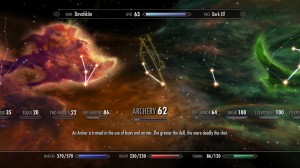
The skill system has been streamlined from what it was in Oblivion and Fallout 3. Skills level up as you use them, and after increasing a set number of skills, your character will level up. It’s here that you will choose to increase your Health, Stamina, or Magicka. Whichever stat you choose will increase by 10, and you will then have a single point to invest into a perk relating to one of the 18 skills that you’ve been leveling up. Every perk after the first in that tree has a requirement for the skill, ensuring that you don’t have perks that outrank your proficiency in that skill. With no way to re-spec your character after spending these points, it’s easy to get to a point where you think that you’ve screwed over your build, but you’ll receive enough points over the course of the game that you can afford to make a few mistakes and still end up with a great character. On a whole the interface is pretty good. On pausing the game, you’ll be taken to a four-way menu where you can access your spells, map, skills, and inventory. Encumbrance has made a return here, so you’ll need to make sure that you keep your weight below a certain amount or risk becoming overencumbered, which can be frustrating at times. Your carrying weight can be increased in a few ways, including a buff found in the world that raises your carrying capacity by 100 (USE THIS), and it can be further increased by a certain enchantment on armor and by improving your stamina (also handy if you find yourself sprinting everywhere).
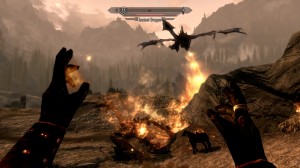 The combat is largely as it was in Oblivion, although it’s been improved in some key ways. There is now a robust dual-wielding system that allows players to mix and match between weapons, shields, and magic as they wish. I played through most of the game as a mage, summoning minions and hurling fireballs, and I had a great time doing it. The melee combat largely feels like it has in past Bethesda games, which is to say that the weapons often have good heft, but sometimes it feels as though you’re just mashing on a button to swing back and forth, there’s not a ton of finesse to it. Finesse comes more into play with the shields, as there’s a bash move that can be performed while blocking that will cancel many enemies’ attacks and stagger them for a moment. As I got some great equipment towards the end of the game and my enchantment skill got to the point where I could place incredible buffs onto armor and weapons, I began experimenting in stealth, and had a great time with that as well. By the end of my game I had an armor set that allowed me to cast Destruction magic for no cost, and another set that made me practically undetectable if I was crouched. If you invest in your skills the right way, it’s easy to feel like a god after a certain number of hours spent with the game. But, there’s always tough enemies that can still give you a run for your money in all but the most specific of builds. And then, there’s dragons. As mentioned before, dragons have returned to Skyrim, and it’s very quickly discovered in the main quest that you are what they call Dragonborn, able to learn words of the dragon language (Words of Power) and absorb the souls of defeated dragons, giving power to those words. This results in what the game calls Shouts, a magic-like ability that runs on a cooldown instead of Magicka. These have a wide range of effects, from a Shout that knocks over enemies in front of you to one that has you breathing fire. Many of the words for these skills are found in various tombs and shrines throughout Skyrim, further encouraging players to explore the world and discover these things on their own. And, if lore is your thing, there’s a ton of books to be found and perused in the world. Many of these will raise a skill, but many others are just for expansion of the world, and it really helps to immerse you into Skyrim’s fantasy setting.
The combat is largely as it was in Oblivion, although it’s been improved in some key ways. There is now a robust dual-wielding system that allows players to mix and match between weapons, shields, and magic as they wish. I played through most of the game as a mage, summoning minions and hurling fireballs, and I had a great time doing it. The melee combat largely feels like it has in past Bethesda games, which is to say that the weapons often have good heft, but sometimes it feels as though you’re just mashing on a button to swing back and forth, there’s not a ton of finesse to it. Finesse comes more into play with the shields, as there’s a bash move that can be performed while blocking that will cancel many enemies’ attacks and stagger them for a moment. As I got some great equipment towards the end of the game and my enchantment skill got to the point where I could place incredible buffs onto armor and weapons, I began experimenting in stealth, and had a great time with that as well. By the end of my game I had an armor set that allowed me to cast Destruction magic for no cost, and another set that made me practically undetectable if I was crouched. If you invest in your skills the right way, it’s easy to feel like a god after a certain number of hours spent with the game. But, there’s always tough enemies that can still give you a run for your money in all but the most specific of builds. And then, there’s dragons. As mentioned before, dragons have returned to Skyrim, and it’s very quickly discovered in the main quest that you are what they call Dragonborn, able to learn words of the dragon language (Words of Power) and absorb the souls of defeated dragons, giving power to those words. This results in what the game calls Shouts, a magic-like ability that runs on a cooldown instead of Magicka. These have a wide range of effects, from a Shout that knocks over enemies in front of you to one that has you breathing fire. Many of the words for these skills are found in various tombs and shrines throughout Skyrim, further encouraging players to explore the world and discover these things on their own. And, if lore is your thing, there’s a ton of books to be found and perused in the world. Many of these will raise a skill, but many others are just for expansion of the world, and it really helps to immerse you into Skyrim’s fantasy setting.
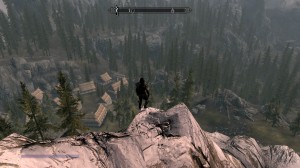 The graphics are pretty great, on the whole. I’ve spent all of my time with the PC version, and it looks quite good. If I had to sum up the aesthetic in a single word, it would be viking. The Nords, as the name might suggest, are a very viking-like people. You’ll find no shortage of longships and vaguely Swedish accents, along with a lot of snowy mountains. That’s not to say the environments aren’t diverse, because once you trek down to some of the more southern areas the greenery definitely starts to show, and all of the vistas are gorgeous. The one place where it falls flat for me are the people. The citizens of Skyrim are often a tad more blocky than you might expect from a AAA title these days, and I’ve had some weird graphical issues with ladies sitting by fires and developing a severe case of bumpy-face.
The graphics are pretty great, on the whole. I’ve spent all of my time with the PC version, and it looks quite good. If I had to sum up the aesthetic in a single word, it would be viking. The Nords, as the name might suggest, are a very viking-like people. You’ll find no shortage of longships and vaguely Swedish accents, along with a lot of snowy mountains. That’s not to say the environments aren’t diverse, because once you trek down to some of the more southern areas the greenery definitely starts to show, and all of the vistas are gorgeous. The one place where it falls flat for me are the people. The citizens of Skyrim are often a tad more blocky than you might expect from a AAA title these days, and I’ve had some weird graphical issues with ladies sitting by fires and developing a severe case of bumpy-face.
That brings me to my other point, and that’s who messed up some stuff in the game is. It’s to be expected in any sandbox game like this, but it bears mentioning all the same. Throughout my many hours with the game, I encountered several quests where I had to go and fetch an item and return it to someone, only to receive my reward along with the item staying in my inventory and never able to be removed. These items amounted to about 10 pounds of weight, which doesn’t sound like a lot, but it’s still wasted space that could be better used by a few more potions or another few pieces of armor. There’s also some silly stuff that happens in the world, but it makes me laugh a lot more than gets me frustrated with the game. A great example are these giants that walk around in certain areas. They won’t attack unless you get too close, but if you provoke them then be prepared to go flying when they hit you with their giant clubs. Like, hundreds of feet into the air. It’s something that’s bound to happen, and it’s still hilarious whenever I see it happen. Not so hilarious are the crashes, which happened to me a few times while I played. From what I’ve seen online, it’s not something happening to everyone, so it may be something specific to my rig, but it’s frustrating nonetheless. Fortunately, autosaves are fairly frequent unless you’re in one area for a lengthy amount of time, and I quickly developed a habit of quicksaving every once in a while anyway (something that I’d imagine would be a bit more tedious on consoles). Load times are great on the PC, but from everything I’ve seen and heard, the console load times are significantly longer. Add that to the inevitable mods that are coming, and I’d say that if your PC can handle it, then that’s the version of Skyrim to grab.
I realize that Skyrim isn’t for everyone, and even if you enjoy it you might not spend nearly as long as I did with it, but there’s just so much to be seen in this game that I feel people at least need to give it a shot. I probably haven’t seen the inside of half of the random dungeons, and I’ve started a new character specializing in archery and fisticuffs, which I’m pretty pumped to get into. Skyrim is a serious contender for my game of the year, and that’s saying something in a year that’s seen Gears of War 3, Portal 2, Dark Souls, Deus Ex: Human Revolution and many more fantastic games. I recommend it to anyone that even thinks they might like it. Now, if you’ll excuse me, I need to go punch a dragon.

Leave a Reply
You must be logged in to post a comment.